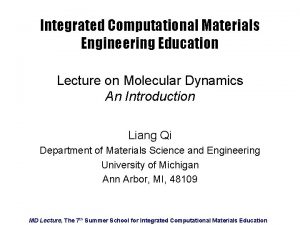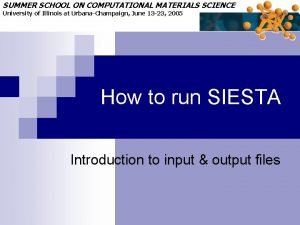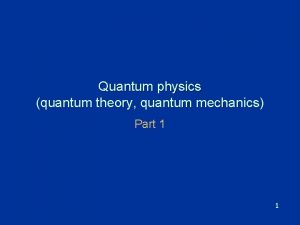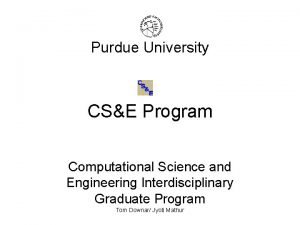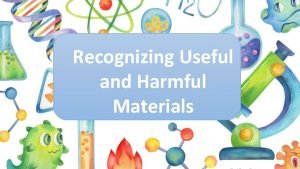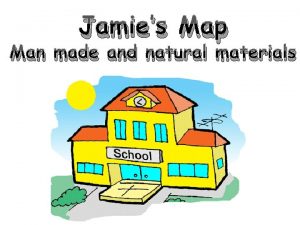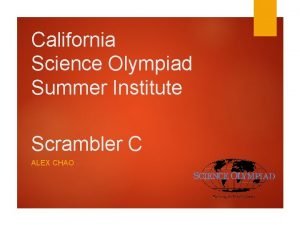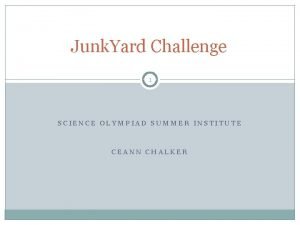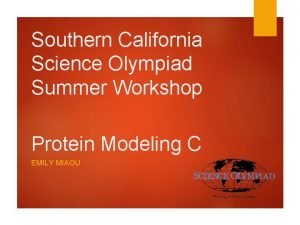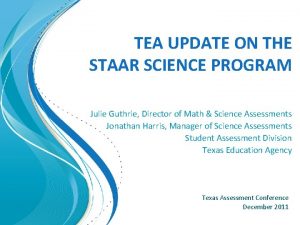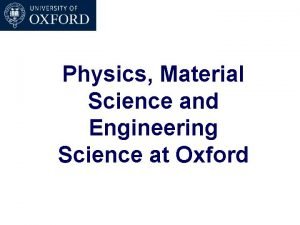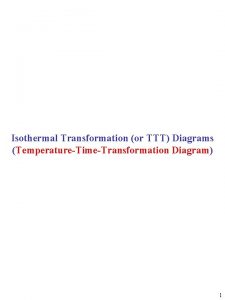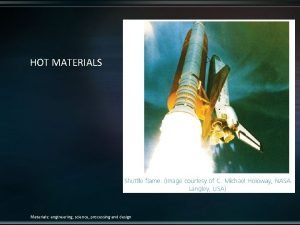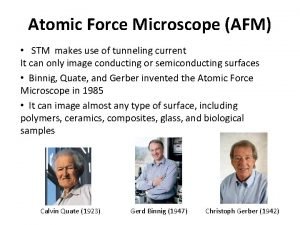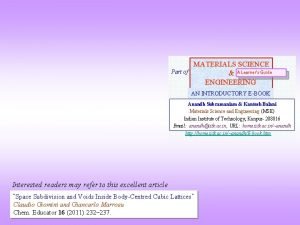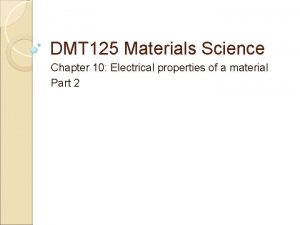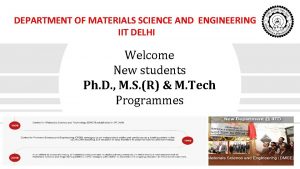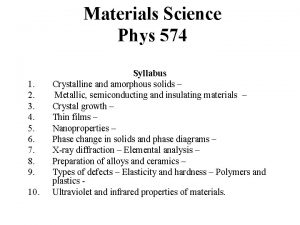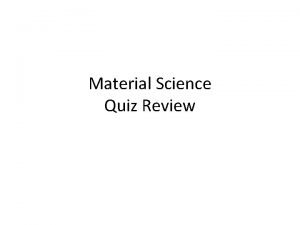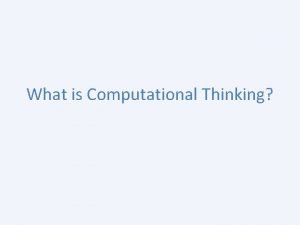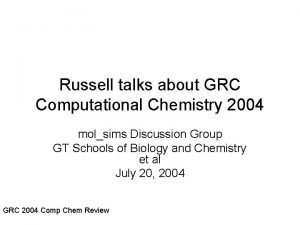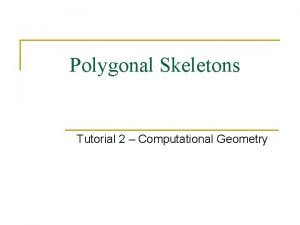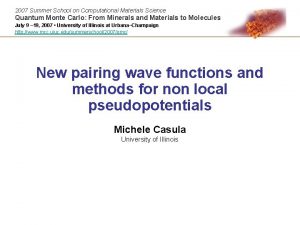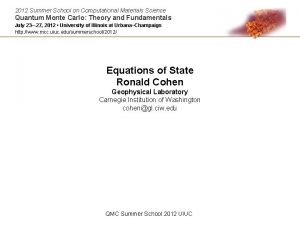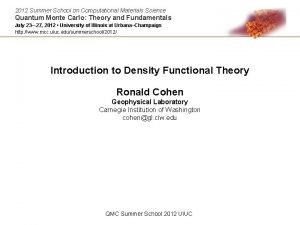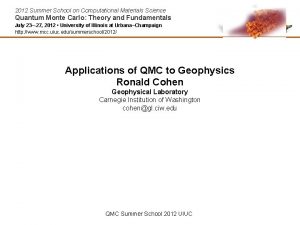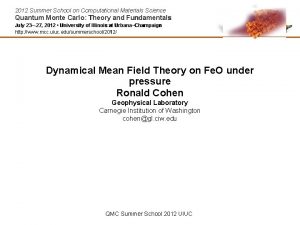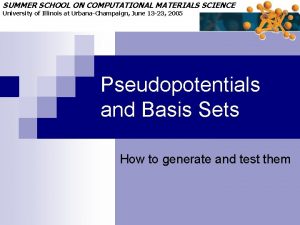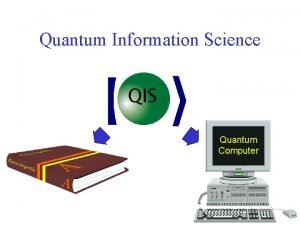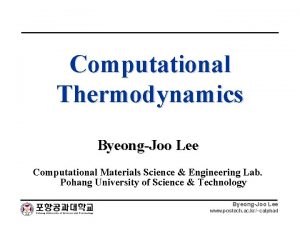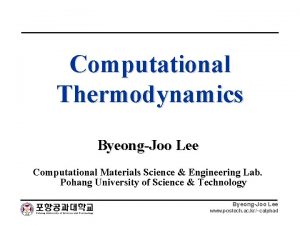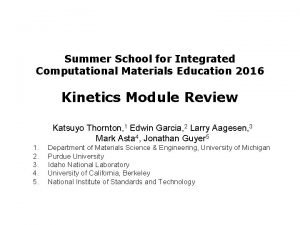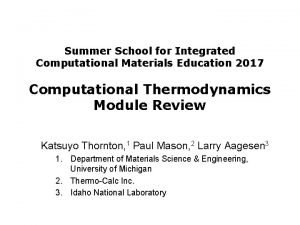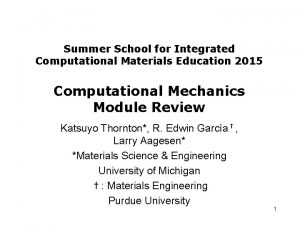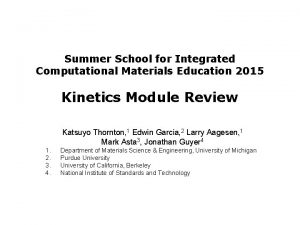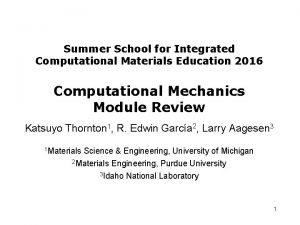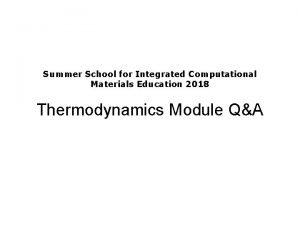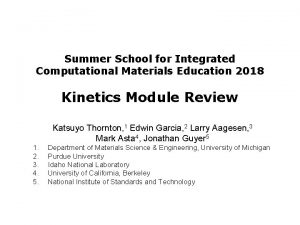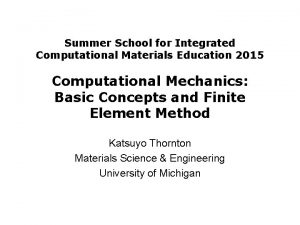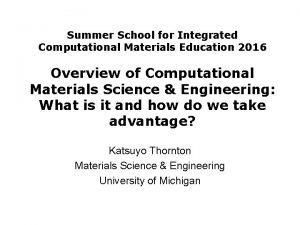2007 Summer School on Computational Materials Science Quantum







































- Slides: 39

2007 Summer School on Computational Materials Science Quantum Monte Carlo: From Minerals and Materials to Molecules July 9 – 19, 2007 • University of Illinois at Urbana–Champaign http: //www. mcc. uiuc. edu/summerschool/2007/qmc/ QMC Studies of Real Systems Neil Drummond TCM Group, Cavendish Laboratory, University of Cambridge Monday 16 th July, 2007

Real Systems There have been many important applications of QMC to model systems (e. g. electron gases, jellium surfaces and spheres). Real systems (atoms, molecules and solids) usually require more computational effort. QMC is most accurate firstprinciples total-energy method for systems of more than a few tens of electrons. QMC is becoming an important tool in ab initio studies of real systems.

Electronic-Structure Methods Accuracy Topological Qualitative Empirical 0. 1 e. V Tight binding 0. 01 e. V DFT 0 QMC 1 10 10, 000 Number of atoms in simulation 1, 000

Outline of Talk + References QMC studies of solid diamond [Maezono et al. , PRL 98, 025701]. QMC studies of solid neon [Drummond & Needs, PRB 73, 024107]. QMC calculations of optoelectronic properties of diamondoids [Drummond et al. , PRL 95, 096801]. Ex nihilo structure prediction (silane & solid hydrogen) [Pickard & Needs PRL 97, 045504; Pickard & Needs, Nature Physics (online)]

Solid Diamond Zero-temperature equation of state of diamond is imperfectly characterised. Knowledge of Eo. S is important in design of diamond anvil cells. Raman frequency: zone-centre optic -phonon frequency, measured in Raman spectroscopy of diamond could be used as a pressure gauge if Raman frequency as a function of pressure were known Use QMC to calculate Eo. S and Raman frequency of diamond. Heart of eternity Diamond anvil cell

Designing the Calculations Calculate QMC energy at different volumes and fit Vinet Eo. S. Like particle-physics experiments, QMC calculations are expensive. Simulate fitting of Eo. S to data from DFT Eo. S with added noise and identify the volume range that allows the Eo. S parameters to be determined with maximum accuracy.

The QMC Calculations Use Dirac-Fock pseudopotentials for C 4+ cores. Use simulation cells consisting of 4× 4× 4 & 5× 5× 5 primitive cells (128 & 250 atoms). Use plane-wave DFT calculations, then re-express orbitals in a blip basis. Single-particle finite-size errors are small; extrapolate to infinite system size using E(N)=E(∞)+b/N. Add DFT quasiharmonic free energy at 300 K. Compare with experimental results: Mc. Skimin & Andreatch, J. Appl. Phys. 43, 2944; Occelli et al. , Nat. Mater. 2, 151.

Equation of State LDA PBE VMC DMC Exp. V 0 (a. u. ) 37. 31 38. 61 37. 82(6) 38. 54(6) 38. 284 B 0 (GPa) 454 422 472(4) 437(3) 442(4) B'0 3. 72 3. 8(1) 3. 7(1) 4(5), 3. 0(1) 3. 65 VMC and DMC in good agreement. DFT and QMC in good agreement. Need to refine ruby pressure scale?

Raman Frequency Frozen phonon method used. Cubic anharmonicity determined, and renormalised phonon frequencies found. LDA PBE VMC DMC Exp. ω (cm-1) [harm. ] 1281 1292 1389(3) 1375(4) N/A ω (cm-1) [ren. ] 1263 1277 1373(4) 1359(4) 1333

Neon The chemistry of the noble gas neon is simple. When atoms are brought together, their electron clouds overlap, giving a hard-core repulsion. Atoms are weakly attracted to one another by van der Waals forces. Can QMC methods describe van der Waals forces? Two electrically neutral, closedshell atoms d- Temporary dipole resulting from quantum fluctuation d+ Gives net attraction d- d+ Induced dipole, due to presence of other dipole

Solid Neon At low temperatures or high pressures, neon forms a crystalline solid with the face-centred cubic structure. Highly accurate experimental data are available. Solid neon has long been used as a test system for theoretical many-body physics. Accurate pressure-volume data at high pressures may be of relevance to diamond-anvil experiments. Diamond anvil Metal gasket Pressure-conducting medium, e. g. neon Sample

QMC Calculations I Used DFT-LDA orbitals in a Slater-Jastrow trial wave function (CASINO). Used HF neon pseudopot. Appreciable time-step bias in DMC energies. Used same time step in all DMC Eo. S calculations; bias in energy nearly same at each density; hence there is very little bias in the pressure. Verified this by calculating Eo. S at two different time steps: clear that Eo. S has converged.

QMC Calculations II Single-particle finite-size effects are negligible in our QMC results; verified by studying convergence of DFT energy with respect to kpoint sampling. Long-ranged kinetic-energy and Coulomb finite -size biases go as 1/N, where N is the number of electrons. Vinet Eo. Ss were fitted to QMC results in simulation cells of 3 x 3 x 3 and 4 x 4 x 4 primitive unit cells, and the assumed form of the finitesize bias was used to extrapolate the Eo. S to infinite system size.

Equation of State of Solid Neon DFT-LDA and DFT-PBE results disagree significantly.

Equation of State of Solid Neon (II) QMC, unlike DFT, gives an accurate description of van der Waals attractions. Unlike the empirical pair potential, QMC is accurate at high pressure.

Semiconductor Nanoparticles for Optoelectronic Devices (I) Optical gap (OG): difference between ground-state and firstexcited-state energies. Quantum-confinement (QC) effects should raise OGs of nanoparticles above the corresponding bulk band gaps. QC caused by quadratic increase in KE of states when spatially confined. E 1 st ES OG GS 1 st ES GS

Semiconductor Nanoparticles for Optoelectronic Devices (II) Films of nanoparticles can be used to make UV sensors. Si and Ge nanoparticles have been studied extensively; can be integrated with existing devicefabrication techniques. Until recently, carbon nanoparticles have been more difficult to synthesise and study. Diamond band gap (5. 47 e. V) is in the UV range. QC might push the OGs of carbon nanoparticles even further into the UV range: new range of UV sensors. Metal film Nanoparticle film Silicon substrate UV light sensor Si. O 2

Semiconductor Nanoparticles for Electron-Emission Devices Electron affinity (EA) of a molecule: energy released when molecule and a free electron form an ion. EA of a semiconductor: difference between conduction-band minimum and vacuum level. Some hydrogen-terminated diamond surfaces have negative EAs. Hydrogen-terminated carbon nanoparticles should have low or negative EAs. + Molecule e- Molecule EA E Band gap + EA Vacuum level Conduction -band min Valenceband max

Field-Emission Devices (I) Field-emission display (FED) devices: attractive alternative to CRT or LCD displays. CRTs are very unwieldy and power-hungry. LCDs have slow response times, limited viewing angles, limited size and are power-hungry. Existing (prototype) FED devices use electric fields to pull electrons off cold, micron-sized metal tips towards phosphor dots. Very strong fields required, and tips get damaged.

Field-Emission Devices (II) Materials with negative electron affinities will readily emit conduction electrons. Electric field required to pull electrons off such materials does not need to be especially strong. Tips are not required (pixels smaller & more robust). Gate electrode Electron beam Row electrode Electron emitter Phosphor screen

Diamondoids (I) Hydrogen-terminated carbon nanoparticles are called diamondoids. C 29 H 36 C 66 H 64 C 87 H 76

Diamondoids (II) Diamondoids have been isolated from petroleum [Dahl et al. , Science 299, 96]. Crystals of diamondoids have been grown. Functional groups have been added to diamondoids. Hence it is possible to produce polymers and self-assembled monolayers of diamondoids. Crystals of C 26 H 32. OH D’oid C—OH O

Diamondoids (III) Experimentally isolated diamondoids are members of a series. We have used some of these structures in our calculations. From Willey et al. , PRL 95, 113401.

Experimental Results XANES: substantial QC in diamondoids up to several nanometres in diameter [Chang et al. , PRL 82, 5377]. NEXAFS: no evidence of QC in such nanoparticles [Raty et al. , PRL 90, 037401]. No experimental studies of electron affinities of carbon nanoparticles. Several technologically important questions, but experimental results are contradictory or nonexistent. Accurate first-principles simulations are clearly required!

Previous DFT Simulations DFT OGs are always underestimated: infamous “band-gap” problem. One DFT study predicted that diamondoid OGs fall off rapidly as their diameter increases [Raty et al. , PRL 90, 037401]. At 1 nm the OGs were predicted to lie below the band gap of diamond. Another DFT study found that the OGs of the same molecules are substantially higher than the diamond gap [Mc. Intosh et al. , PRB 70, 045401]. More accuracy required? Then use QMC!

The QMC Calculations (I) DFT pseudopotentials were used for C and H. Very large simulation boxes (side-length 3550 a. u. ) and plane-wave cutoff energies (3550 Ry) were used in the DFT calculations. Orbitals were represented by splines in real space to improve scaling of QMC calculations with system size. DMC time step was 0. 02 a. u. ; resulting errors in the gaps are negligible.

The QMC Calculations (II) Changing XC functional used to generate nanoparticle geometry and trial wave function altered DMC OG by 0. 3 e. V. HOMO was replaced by LUMO in spin-down Slater determinant to give excited state. Introduces an error of 0. 1 -0. 2 e. V into excitedstate DMC energy. Overall, DMC OG expected to be within about 0. 5 e. V of true gap.

Optical-Gap Results DFT OGs are lower than DMC gaps by about 2 e. V. DMC OGs decrease rapidly with cluster size, falling below bulk gap at a diameter of 1 nm. Differs from OG behaviour of Si and Ge nanoparticles. DFT qualitatively (but not quantitatively) correct.

Nature of the HOMO and LUMO for Diamondoids (I) HOMO is located on the atoms and bonds within nanoparticle. LUMO is a diffuse surface state for diamondoids; not the case for Si or Ge clusters. HOMO evolves into the valence -band maximum as cluster size increases. LUMO does not evolve into the conduction-band minimum. It’s like a surface or impurity state within the band gap. LUMO is clearly not confined. C 29 H 36 HOMO C 29 H 36 LUMO

Nature of the HOMO and LUMO for Diamondoids (II) LUMO is essentially unbound, suggesting EA will be small or negative. C 29 H 36:

Nature of the HOMO and LUMO for Diamondoids (III) Disagreement between previous DFT results arose because one group used an inadequate Gaussian basis set to describe LUMO artificially localised → spurious QC effect. Convergence of HOMO and LUMO eigenvalues with Gaussian basis set

Electron Affinities of Diamondoids DMC electron DMC ionisation Molecule affinity (e. V) potential (e. V) C 10 H 16 − 0. 13(2) 10. 15(3) C 29 H 36 − 0. 29(6) 7. 63(5) DFT EAs and IPs agree with DMC results. The EAs are negative, as was hoped. Diamondoids are therefore candidates for use as low-voltage electron emitters. Other candidates exist (e. g. CVD diamonds & carbon nanotubes).

Recent Experimental Results Recent studies of small diamondoids [Willey et al. , PRL 95, 113401; Willey et al. , PRB 74, 205432; Yang et al. , Science 316, 1460] have confirmed our predictions. LUMO energy is almost indep. of system size. Diamondoids have negative electron affinities and are good electron emitters.

Ex Nihilo Structure Searching (I) Locating lowest-enthalpy structure within DFT is difficult (NP-hard). Structures are usually identified by either experiment, analogy with similar materials, clever methods for moving between local minima or chemical intuition. New, simple and surprisingly successful method: choose cell vectors randomly, then scale to give desired volume; choose atom coordinates randomly in cell; then relax all coordinates in DFT. Repeat many times. Why has nobody tried this before?

Ex Nihilo Structure Searching (II) Although the number of local minima rises exponentially with system size, many systems of interest are sufficiently simple that this simple randomsearching method works. Continue generating random configurations until the relaxed structures with low enthalpies are generated several times. Where possible, look for known “marker” structures. Implications for QMC: new phases for several different materials are being predicted; where energy differences between phases are small, use QMC to decide between competing phases.

Silane at High Pressure Find lowest enthalpy structures with 2 Si. H 4 units per cell (larger cells have too many degrees of freedom). Having found candidate phases, calculate enthalpies with greater accuracy. BCS suggests C 2/c phase may be high-T superconductor. I 41/a C 2/c

Phase Diagram of Hydrogen (I) Hydrogen: most abundant element in universe and one of the most heavily studied. H atoms scatter X-rays weakly: experiments are difficult. Energy differences between phases are small and zero-point energy is important: theory is difficult. Random-structure searching has led to a major revision of the DFT phase diagram of hydrogen. ZPE is included within the harmonic approximation. Let’s hope that anharmonic effects cancel between phases.

Phase Diagram of Hydrogen (II) P 63/m Solid lines: new phases; Dashed lines: C 2/c phases that have been considered previously. Cmca-12 ZPE included in inset.

Summary & Outlook QMC provides quantitative accuracy where DFT cannot: optical gaps, comparing structures/phases with different bonding, van der Waals forces, . . . QMC can be used to study systems that are completely inaccessible to quantum chemistry methods: solids, clusters, nanoparticles, . . . Computer power is growing exponentially, QMC technology is advancing rapidly and QMC community is growing exponentially.
 Tu bergakademie freiberg computational materials science
Tu bergakademie freiberg computational materials science Integrated computational materials engineering
Integrated computational materials engineering Integrated computational materials engineering
Integrated computational materials engineering Quantum physics vs mechanics
Quantum physics vs mechanics Quantum physics vs quantum mechanics
Quantum physics vs quantum mechanics Cs 514 purdue
Cs 514 purdue Lodi unified summer school
Lodi unified summer school Crescenta valley high school summer school
Crescenta valley high school summer school Haltom high school summer school
Haltom high school summer school My favourite subject is music
My favourite subject is music Natural materials and man made materials
Natural materials and man made materials Examples of harmful and useful materials
Examples of harmful and useful materials Man made map
Man made map Adopting materials
Adopting materials Direct materials budget with multiple materials
Direct materials budget with multiple materials 2007 middle school fashion
2007 middle school fashion Science olympiad summer institute
Science olympiad summer institute Summer science program
Summer science program Vanderbilt summer science academy
Vanderbilt summer science academy Science olympiad summer institute
Science olympiad summer institute Science olympiad protein modeling
Science olympiad protein modeling Biology staar
Biology staar Material science oxford
Material science oxford Matter and materials grade 6
Matter and materials grade 6 Matter and materials grade 7
Matter and materials grade 7 Introduction to materials science for engineers chapter 10
Introduction to materials science for engineers chapter 10 Materials engineering science processing and design
Materials engineering science processing and design Materials science
Materials science Materials science tetrahedron
Materials science tetrahedron Introduction to materials science for engineers chapter 10
Introduction to materials science for engineers chapter 10 Eacademics iitd
Eacademics iitd Grade 6 ns term 2
Grade 6 ns term 2 Materials science
Materials science Materials science quiz
Materials science quiz Ashby plots
Ashby plots Characteristics of computational thinking
Characteristics of computational thinking Computational thinking algorithms and programming
Computational thinking algorithms and programming Grc computational chemistry
Grc computational chemistry Using mathematics and computational thinking
Using mathematics and computational thinking Straight skeleton
Straight skeleton

